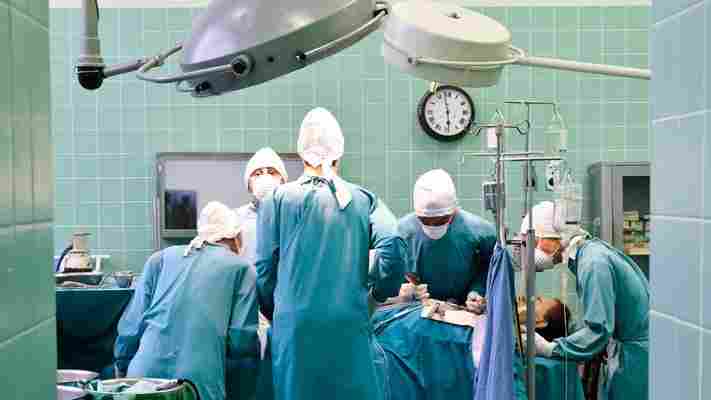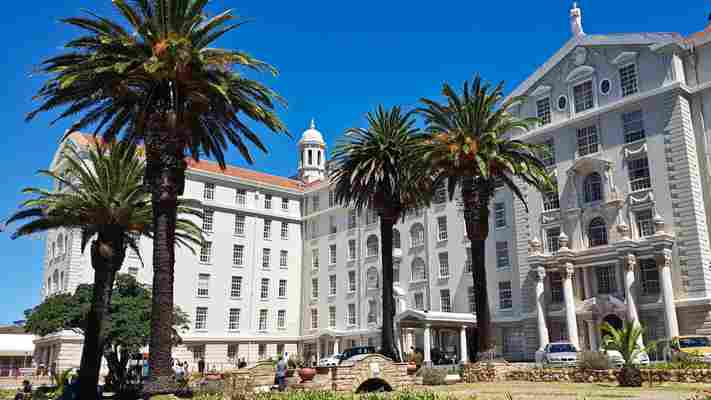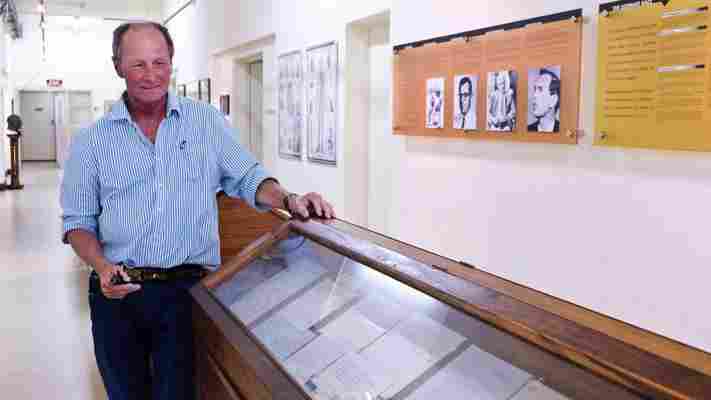Cape Town’s inspiring medical marvel
Dawn was breaking on 3 December 1967, an otherwise unremarkable day in apartheid South Africa. But in operating theatre 2A, deep in the bowels of Cape Town’s Groote Schuur Hospital, history was being made.

Around 06:00, with Professor Christiaan Neethling Barnard watching anxiously from behind his surgical mask, the heart of Denise Darvall lurched unsteadily back to life, slowly finding its rhythm. But one thing had changed. Now, it was beating inside the chest of Louis Washkansky. The world’s first human heart transplant was a success.
This is not just a museum, this is a heritage site
It was a pivotal moment in medical history, an event that made headlines around the world and transformed Barnard into an overnight celebrity. And the journey up to, and beyond, the moment of the world’s first human heart transplant is expertly told in the very corridors where the operation took place.
“This is not just a museum, this is a heritage site,” said Hennie Joubert, founder and curator of The Heart of Cape Town Museum . “This is where it all happened.”

The world’s first successful human heart transplant took place in Cape Town, South Africa’s Groote Schuur Hospital in 1967 (Credit: Richard Holmes)
You may also be interested in: • The Italian city that cured the world • The island that forever changed science • How France created the metric system
The Heart of Cape Town Museum is housed within the walls of Groote Schuur Hospital, one of the largest public hospitals in Cape Town, South Africa. Visiting the museum today, you’ll wander past orderlies in scrubs and family members visiting with care parcels. For as much as this is a heritage site, it remains a frenetic working hospital and the primary teaching hospital for the University of Cape Town’s medical faculty.
Barnard and the heart transplant have long fascinated Joubert. His father and Barnard became friends while studying together at the University of Cape Town, and before Barnard delved into the world of surgery the pair shared a general practice in the small farming town of Ceres.
Joubert sold his oncology business in 2006 and opened the museum in 2007 to mark the 40th anniversary of the operation. “I told my wife that I was going to build a museum by any means possible,” he chuckled. Over the years, Joubert has poured more than R8 million (nearly £440,000) of his own money into the project, renovating and restoring the original operating theatres, creating exhibits and collecting memorabilia from the event.

Hennie Joubert opened The Heart of Cape Town Museum in 2007 to mark the 40th anniversary of the operation (Credit: Richard Holmes)
The museum traces Barnard’s path to medical history across seven exhibition spaces, along with the worldwide research – and rivalry – that paved the way for the first human heart transplant.
For Barnard certainly wasn’t the only heart surgeon hoping to suture their name into the history books. In the United States, Dr Richard Lower and Dr Norman Shumway spent the late-1950s and 1960s perfecting transplant procedures on dogs, and Barnard drew heavily on their research and methods in his own trials with canine ‘patients’ in South Africa.
In exploring these early trials, which took place at the height of South Africa’s apartheid period of racial segregation, the museum also touches briefly on the crucial role black and mixed-race assistants played in the historic transplant. Hamilton Naki, in particular, became famous for his rise from hospital groundskeeper to a skilled member of the team assisting with transplant research in Groote Schuur’s animal laboratory.
And in many ways, South Africa was an unusual place for this medical breakthrough to have taken place. In 1967, the country was in the grips of apartheid, increasingly isolated from the world for its policies of racial segregation.
Performing the world's first successful heart transplant transformed Professor Christiaan Barnard into an overnight celebrity (Credit: Stan Meagher/Getty Images)
But part of Barnard’s success came down to the legal interpretation of death. While South African doctors could pronounce a patient brain dead and make preparations for organ donation, in the US only the absence of a heartbeat qualified a patient as legally dead. Shumway ridiculed this as an antiquated “boy-scout definition of death”, and it nearly saw Lower prosecuted for murder after performing his first heart transplant, the world’s 16th, in May 1968.
Without locating the family of the donor, Bruce Tucker, Lower proceeded with the operation and removed the man’s heart for transplant. When Tucker’s family learned what had happened, they filed a lawsuit for wrongful death. Lower was eventually cleared of any wrongdoing in 1972, and the precedent ultimately changed US legislation on the determination of death.
Well, doctor, if you can’t save my daughter, try and save this man
Death, as much as life, is a thread that runs through the museum, and its most moving corner comes not from the researchers and surgeons battling for fame, but in the bedroom of Denise Darvall, the 25-year-old bank clerk who unwittingly found herself written into the history books.
Running errands with her family on 2 December 1967, she and her mother were knocked down by a car on Main Road, which runs below Groote Schuur. While her mother, Myrtle, was killed instantly, Denise sustained brain injuries that would, hours later, prove fatal. In the museum, the walls of her recreated bedroom are filled with personal effects donated by the Darvall family, including sketches from her diaries and a small bible. Scattered across the bed are a handful of her vinyl records, mostly waltzes and opera of the day.
But what is most striking here are the words, tucked away on a wall display, from her father. Just hours after losing his wife and daughter, doctors asked his permission for Denise’s heart to be transplanted into the chest of a desperately ill 54-year-old patient. His reply?
“Well, doctor, if you can’t save my daughter, try and save this man.”
Barnard’s success came after years of worldwide research – and rivalry (Credit: Richard Holmes)
That man was Louis Washkansky, who we find – in mannequin form – in a ward bed in another room. He’d been admitted with little hope of a cure for his progressive heart failure. Look carefully at the copies of the medical charts above his bed and one scrawled doctor’s comment stands out.
“No operation will help. Let nature take its course.”
Barnard disagreed, and the ambition of this young surgeon is well told in the recreation of his office. Wall panels trace his journey from humble beginnings as a pastor’s son in the semi-desert town of Beaufort West to his frustrations in general practice to his later surgical training in the US. In the adjoining auditorium, a 26-minute documentary unpacks the many facets of Barnard: a brilliant surgeon, but a man who generated controversy throughout his career.
The Heart of Cape Town Museum is housed in the Groote Shuur operating theatres where the transplant took place (Credit: Richard Holmes)
All of which is a prelude to the pair of operating theatres where the historic transplant took place in the early hours of 3 December 1967. Theatre 2A, where Washkansky lay waiting on an operating table for a new heart, and 2B, where Darvall lay ready to donate hers.
“I wanted to make the museum back to exactly how it looked the night of the operation. I became obsessed with it,” Joubert reminisced.
Happily, the bureaucracy of South Africa’s public health system proved useful.
“The documentation of Groote Schuur Hospital was very accurate, so all the serial numbers of all the equipment that was in the theatre the night of the operation was available,” Joubert recalled.
Returning the equipment to its original home didn’t always prove simple, though. The theatre bed on which Darvall lay in theatre 2B had been donated to the Roman Catholic Hospital in the Namibian capital, Windhoek.
“I phoned the head of the hospital and explained that I needed the bed back in Cape Town because it’s part of history, South African history,” Joubert said. He replaced the bed with a new one and brought the original back to Cape Town.
The theatre light from 2B had also been sold off, but Joubert tracked it down to a local veterinary hospital and convinced the owners to return the original to the museum.
The museum features a recreation of the bedroom of Denise Darvall, the 25-year-old bank clerk whose heart was used for the transplant (Credit: Richard Holmes)
The inclusion of original memorabilia lends a definite authenticity to the museum.
In theatre 2A, the original heart-lung machine that kept Washkansky alive stands in place to one side. The scale used to measure blood loss was tracked down in a hospital storeroom, and today can be found at the nurse’s station in theatre 2A. In Barnard’s recreated office, his mannequin sits behind the original desk from his office at the University of Cape Town. The old leather doctor’s satchel on the mantelpiece is from his time as a general practitioner in Ceres.
In the corridor outside the operating theatres, display cases are filled with the original telegrams and letters that flew in from across the globe once news of the transplant broke. Shumway sent Barnard his congratulations – and no doubt unwelcome advice on post-operative care.
But not everyone hailed the achievement.
“To the butcher of Groote Schuur Hospital,” reads a note from Mary Power Slattery in Chicago. “A bunch of ghouls, all of you,” wrote S Peschel from Arlington, Virginia.
Hennie Joubert: “I wanted to make the museum back to exactly how it looked the night of the operation. I became obsessed with it” (Credit: Richard Holmes)
But of all the artefacts in the Heart of Cape Town Museum, the most important are surprisingly easy to miss.
Inside a glass case set into the walls of theatre 2B, you’ll find two glass cubes filled with formaldehyde preserving two important artefacts. On the left: the diseased heart that had failed Louis Washkansky. On the right: the heart of Denise Darvall that turned Barnard into a household name.
Washkansky lived for only 18 days after the transplant, eventually succumbing to double pneumonia. But as he breathed his last, Darvall’s heart was still beating strongly inside the chest of another human being.
Places That Changed the World is a BBC Travel series looking into how a destination has made a significant impact on the entire planet.
Join more than three million BBC Travel fans by liking us on Facebook , or follow us on Twitter and Instagram .
If you liked this story, sign up for the weekly bbc.com features newsletter called "If You Only Read 6 Things This Week". A handpicked selection of stories from BBC Future, Culture, Capital and Travel, delivered to your inbox every Friday.

